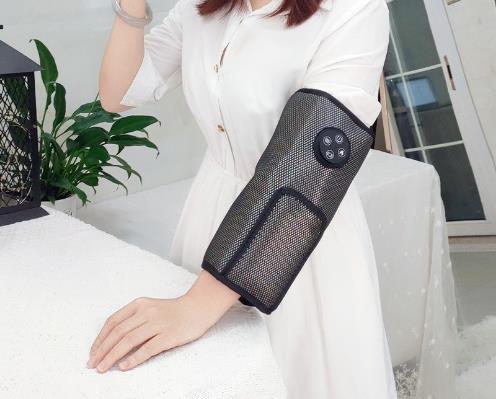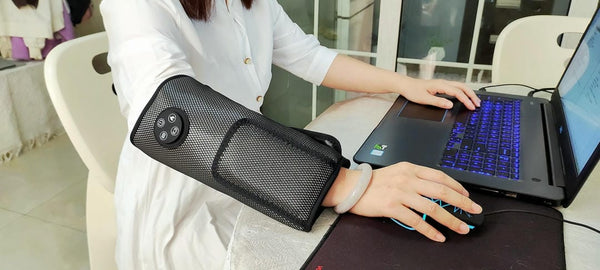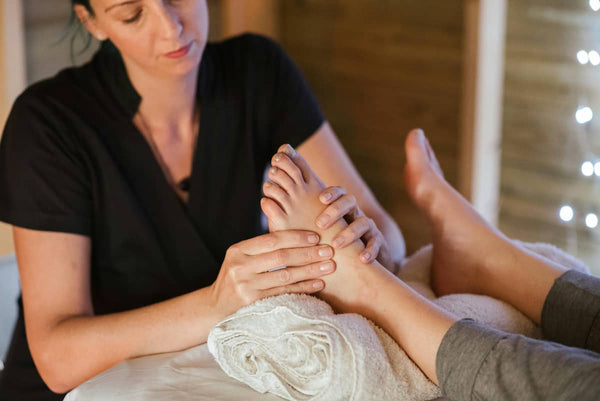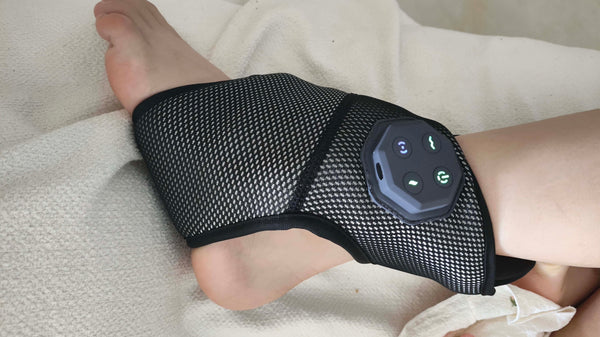
If you're a daily commuter, you know the feeling: a stiff lower back from the driver's seat, tense shoulders from gripping the wheel, or general aches from a long train ride. You've decided to get a massager, but a quick search reveals a confusing choice: vibration or percussion? They both promise relief, but they work in fundamentally different ways. Understanding this difference is the key to picking the right tool to soothe your daily aches and pains.
Many people use the terms interchangeably, but they describe distinct types of therapy. One feels like a deep, pulsing action, while the other provides a more generalised soothing sensation. Let’s break down what each one does, how they differ, and which type of massage machine will truly meet your needs and give you those good vibrations massage feelings after a long day.
What is a Vibration Massager?
Think of a vibrating massager as creating ripples on the surface of a pond. The device's head oscillates rapidly but with a very shallow amplitude, meaning it doesn't push deep into the body. This action spreads energy over a wider area of your skin and superficial muscle layers. The primary goal is to stimulate blood flow, warm up tissues, and provide a soothing, relaxing sensation.
A vibration massager is fantastic for general tension relief and relaxation. The broad, gentle movement is less intense and often more comfortable, especially for sensitive areas or for users new to massage devices. It's an excellent choice for waking up muscles before activity or for calming down an overstimulated nervous system after a stressful commute.
This type of massage vibration is perfect for large muscle groups like your back, thighs, or calves, where you want to promote overall blood circulation and ease mild stiffness rather than targeting a specific, deep knot. It’s a gentle giant in the world of personal massage.
What is a Percussion Massager?
Now, imagine a single raindrop hitting that same pond. That’s percussion. A percussion massager, often called a massage gun, uses a repetitive, hammer-like motion that pushes deep into the muscle tissue. Brands like Theragun are well-known examples of this technology. The head of the device travels a significant distance back and forth, delivering targeted bursts of pressure.
This deep-tissue action is designed to break up tough muscle knots, release adhesions in the fascia (the connective tissue surrounding muscles), and accelerate recovery after intense physical activity. Because it's so focused and intense, it's a favourite among athletes and those dealing with chronic, deep-seated muscle soreness. Have you ever felt a knot that seems impossible to reach? That's what percussion therapy is built for.
However, this intensity can also be a drawback. For some people, especially those with sensitive muscles or certain medical conditions, the powerful thumping can be uncomfortable or even painful. It’s a specialised tool for a specific job: targeted, deep-tissue work.
The Best of Both: Adjustable & Hybrid Devices
 In the past, you had to choose between the gentle hum of vibration and the intense pulse of percussion. Today, the lines are blurring. Modern devices are being engineered to offer a more versatile experience, providing the benefits of both worlds in a single, smart massage tool.
In the past, you had to choose between the gentle hum of vibration and the intense pulse of percussion. Today, the lines are blurring. Modern devices are being engineered to offer a more versatile experience, providing the benefits of both worlds in a single, smart massage tool.
Take the KLcosy range, for example. Their devices use an advanced form of Targeted Vibration Therapy. This isn't just a simple buzz; it's a high-frequency vibration that can be adjusted to different intensity levels. At lower settings, it provides a gentle, soothing massage vibration ideal for relaxation and improved circulation—much like a traditional vibrating massager.
But when you ramp up the intensity, the vibrations penetrate deeper to relax muscles, break up tension, and relieve fatigue more effectively. While not a true "percussive" motion, this powerful, adjustable vibration allows you to get closer to a deep-tissue experience without the sometimes harsh impact of a massage gun. It’s a hybrid approach that offers flexibility for your changing needs—perfect for a commuter who might need gentle relaxation one day and deeper relief the next.
Which Massager Is Right for Your Commute?
At the end of the day, the right choice comes down to your primary goal. Let's make it simple:
- Choose a dedicated VIBRATION massager if: Your main goal is relaxation and stress relief. You have sensitive muscles, are new to massage tools, or want to treat large areas with gentle, soothing warmth and movement.
- Choose a dedicated PERCUSSION massager if: You're an athlete or have very dense muscle tissue. You need to target specific, stubborn knots and are looking for intense, deep-tissue recovery.
- Consider an ADJUSTABLE or HYBRID massager if: You're like most commuters. Your needs vary. You want the flexibility to have a gentle, relaxing massage after a stressful day but also the power to work on a sore back or tight shoulders when needed.
For most people who aren't elite athletes, a versatile device with adjustable intensity offers the most practical and comfortable solution for everyday aches and pains.
Find Your Perfect Massage Match
Choosing between a vibrating massager and a percussion massager is about matching the tool to your needs. While percussion offers deep, targeted relief for athletes, the gentle, widespread benefits of vibration are often more suitable for daily relaxation. Better still, modern adjustable devices give you the control to tailor your massage, providing the perfect therapy whether you're warming up, winding down, or working out a tough knot.
Frequently Asked Questions
What vibrating massagers offer adjustable intensity?
Many modern vibrating massagers come with multiple speed or intensity settings. When you're looking for the best viberator for your needs, this is a key feature to check. Brands like KLcosy build their devices, such as the Arm, Leg, and Lumbar massagers, with adjustable levels of their Targeted Vibration Therapy, allowing you to customise the experience from a gentle hum to a more vigorous, deep-reaching vibration.
How to evaluate the battery life of a vibrating massager?
Check the product specifications for the battery capacity (measured in mAh) and the estimated run time in hours. A good quality massager should provide at least 2-3 hours of use on a single charge. Also, consider the charging method. Devices that use a standard USB-C charger are more convenient for travel and daily use, as you won't need a specialised power adapter.
Are vibrating massagers safe for sensitive skin?
Generally, yes. Vibration massagers are often preferred for sensitive users because they don't have the intense, pounding impact of percussion massagers. Look for devices made with soft, hypoallergenic materials that come into contact with the skin. If you have particularly sensitive skin, it's always a good idea to start on the lowest intensity setting and use the massager over a thin layer of clothing first.




0 comments